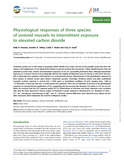Physiological responses of three species of unionid mussels to intermittent exposure to elevated carbon dioxide
Metadata
Show full item recordAuthor
Hanna, Kelly D.
Jeffrey, Jennifer D.
Hasler, Caleb T.
Suski, Cory D.
Date
2016-12-29Citation
Hanna, Kelly D., Jennifer D. Jeffrey, Caleb T. Hasler, and Cory D. Suski. "Physiological responses of three species of unionid mussels to intermittent exposure to elevated carbon dioxide." Conservation Physiology 4 (2016):cow066. DOI: https://doi.org/10.1093/conphys/cow066.
Abstract
Freshwater systems are at risk owing to increasing carbon dioxide (CO2) levels, and one of the possible reasons for these elevations is the deployment of non-physical fish barriers to prevent invasive fish movements. Carbon dioxide barriers have the potential to create short, chronic and intermittent exposures of CO2 for surrounding freshwater biota. Although intermittent exposures to a stressor may be more ecologically relevant, the majority of laboratory tests use chronic or short-term time periods to determine how organisms will respond to an environmental stressor. Measurements of the physiological responses of three species of unionid mussel, giant floaters (Pyganodon grandis), threeridge (Amblema plicata) and plain pocketbook (Lampsilis cardium), exposed to control pCO2 (~1000 μatm) or intermittent conditions of pCO2 (ranging from ~1000 to ~55 000 μatm) 12 times per day over a 28 day period were gathered. There was no indication of recovery in the physiological responses of mussels between applications of CO2, suggesting that the recovery time between CO2 pulses (1.5 h) was not sufficient for recovery from the CO2 exposure period (0.5 h). Observations of acid–base and stress responses were consistent with what has been observed in chronic studies of freshwater mussels exposed to elevated pCO2 (i.e. elevations in HCO3−, Ca2+, Na+ and glucose, and decreases in Mg2+ and Cl−). However, species differences were observed across almost all variables measured, which emphasizes the need for multispecies studies.

